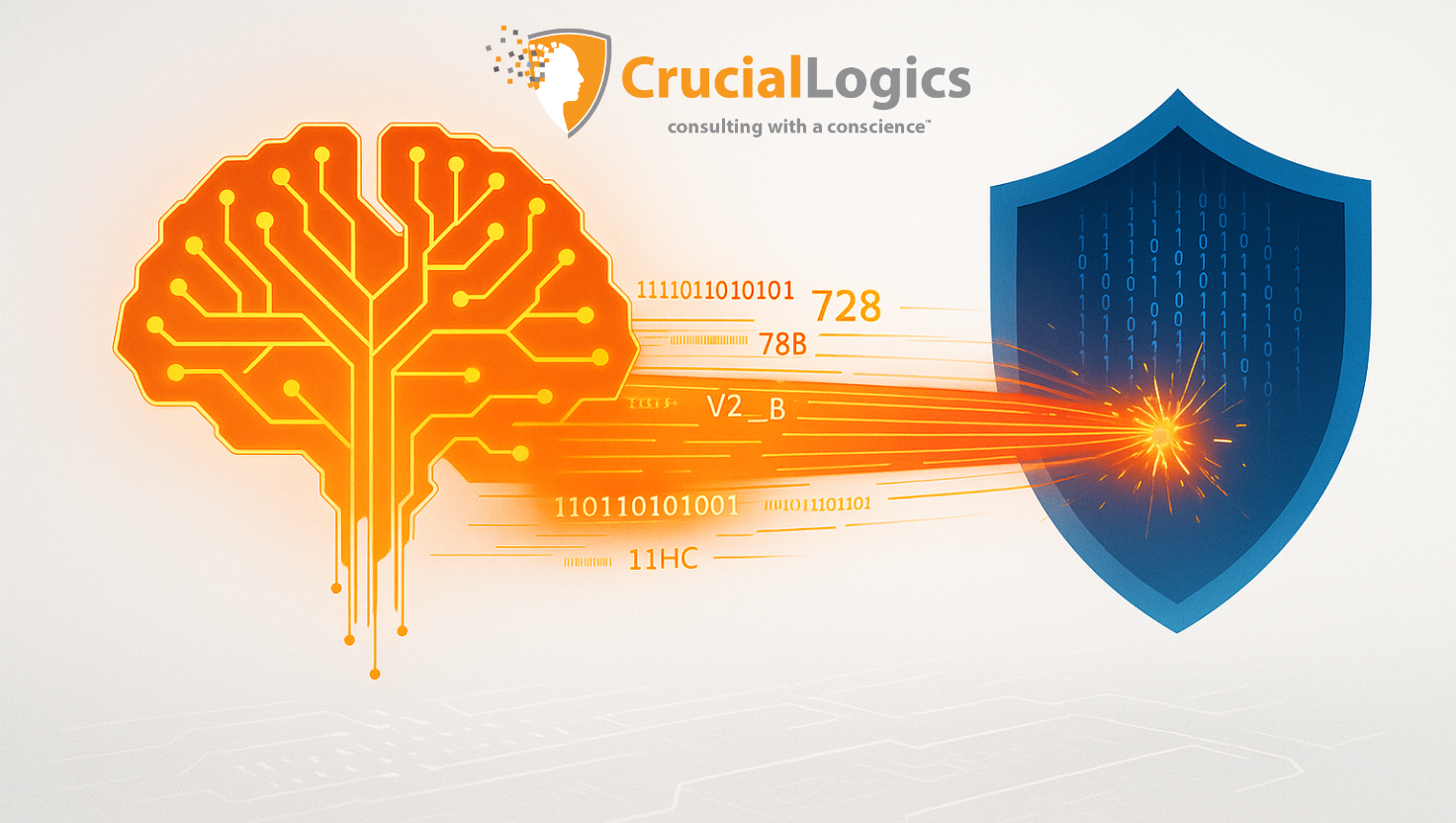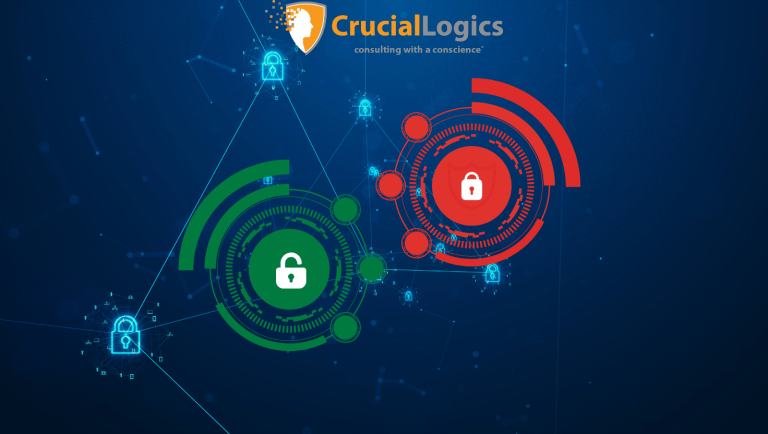The virtual battlefield is evolving. Cyberattacks by malicious actors are no longer a nuisance; they’ve become organized and sophisticated operations capable of crippling businesses and their entire infrastructure. In such a high-stakes environment, traditional, manual cybersecurity can no longer keep up.
Artificial Intelligence (AI) has transformed how we protect IT infrastructure. Yet, it carries a clear dichotomy, being leveraged by both security specialists and malicious actors.
In this article, we’ll explore how AI is implemented in cybersecurity, highlight key use cases, examine the associated risks, and outline how organizations can deploy it safely and effectively.
The Augmentation of Manual Defense With AI Cybersecurity
Traditional cybersecurity has always been response-based. It relies on signature detection and manual analysis, which can no longer keep up with the volume and speed of modern attacks. No security team can sift through thousands of alerts a day and still stay ahead of emerging threats.
AI changes that reality. It shifts defense from reactive to predictive. Security Operations Centers are beginning to use AI to hunt threats before they cause damage. These systems process massive amounts of data, identify unusual patterns, and detect changes in user behavior that may point to malicious intent.
What makes this shift meaningful is how it blends automation with human insight. AI takes on the heavy, repetitive work like sorting alerts, correlating data, filtering false positives—while analysts focus on judgment, context, and strategy.
AI gives cybersecurity professionals the visibility and speed they need to make smarter, faster decisions when every second matters.
Related resource – How Microsoft Security Copilot Is Changing Security Monitoring/
Use Cases of AI in Modern Cybersecurity
AI-powered systems can recognize patterns and behaviors that would otherwise go unnoticed, identifying attacks designed to evade conventional defenses.
AI Threat Detection and Proactive Threat Hunting
AI’s most important contribution to cybersecurity lies in how it transforms threat detection. Instead of relying on known malicious signatures, modern AI models learn what normal behavior looks like within a network. They build a baseline of how users, systems, and devices typically operate, then flag anything that deviates from that pattern.
- Real-time Anomaly Detection
AI can identify unusual activity as it happens. This includes abnormal data transfers, suspicious logins from unexpected locations, or unauthorized access to sensitive files. By learning from context, AI often uncovers insider threats and advanced persistent threats that traditional tools overlook.
- AI-Assisted Cyber Threat Intelligence
AI systems can also process millions of threat signals across both the open and dark web, finding connections and uncovering new attack campaigns long before they escalate. This provides defenders with early warnings and the context needed to respond quickly and accurately.
Related resource – How Microsoft Sentinel Strengthens Threat Detection and Response
Automation of Incident Response and Orchestration
When a security incident occurs, speed is everything. The faster a threat is detected and contained, the smaller the impact. AI has changed how quickly that happens.
- Data Security Automation and Workflow Optimization
AI can triage and correlate alerts in seconds, separating real threats from false positives. Once a genuine incident is confirmed, AI can trigger automated playbooks to contain it by isolating compromised endpoints, blocking malicious IP addresses, or revoking stolen credentials within milliseconds.
The result is a faster and more coordinated response that limits damage and helps security teams maintain control even under pressure.
Proactive Vulnerability Management
The number of new software vulnerabilities that appear each year is far beyond what any human team can manage alone. AI brings intelligence and speed to this process, helping organizations stay ahead of potential weaknesses before they become active threats.
- AI-Assisted Code Scanning
AI can analyze code during development to identify flaws and vulnerabilities long before a product is released. This approach shifts security to the earlier stages of the development cycle, allowing developers to fix issues before they reach production.
- Automated Discovery and Prioritization of Vulnerabilities
AI not only finds vulnerabilities but understands them in context. It evaluates how easily a weakness can be exploited, the potential business impact, and how likely threat actors are to target it.
Advanced Behavioral Analytics (UEBA)
User and Entity Behavior Analytics (UEBA) identifies sophisticated threats that move past traditional perimeter defenses. Instead of relying on static rules, AI models learn how users, devices, and systems typically behave, then flag any activity that deviates from those norms.
- Insider Threat Detection
AI helps detect when an employee acts outside their usual behavior pattern. This could be an intentional act, such as data theft, or an unintentional one, like mistakenly accessing sensitive information. By spotting these anomalies early, organizations can prevent internal incidents before they escalate into full-scale breaches.
- Compromised Account Identification
AI can also detect when user credentials have been stolen and used by attackers. Even if activity appears legitimate on the surface, subtle behavioral changes such as login time, access frequency, or data movement can reveal a compromised account.
Behavioral analytics provides an added layer of visibility that complements existing security measures. It allows teams to identify hidden threats that would otherwise blend into normal activity, strengthening trust and control across the entire digital environment.
The Dark Side of AI in Cybersecurity
The same technology that protects organizations are now being used by attackers to outsmart them. An effective security strategy must recognize this dichotomy and plan for it.
Adversarial AI and Model Poisoning
AI models are only as reliable as the data they learn from. If that data is corrupted, manipulated, or poisoned, the model can be deceived into making poor decisions. Threat actors can intentionally inject misleading data into training sets, forcing the system to misclassify threats or ignore real attacks. They can also craft inputs designed to trick AI detectors, such as making a malicious file appear harmless.
Advanced Social Engineering
Attackers can now generate personalized phishing messages that sound authentic and create deepfake audio or video to impersonate executives. These tactics have made fraudulent transactions and data breaches far easier to execute and much harder to detect.
Algorithmic Bias and Discrimination
AI is only as fair as the data it learns from. If that data carries bias, the system will mirror it. A model trained on incomplete or skewed information might start treating certain departments, users, or regions at higher risk without any real basis.
Accountability and Transparency
When an AI-driven system makes a mistake, such as blocking normal traffic or missing a breach, it raises hard accountability concerns. Without a clear understanding of how decisions are made, auditing, improving and trusting AI systems becomes difficult.
Over-Reliance and Skill Gaps
Placing blind trust in AI can lead to complacency. Analysts may begin to second-guess their own judgment or accept system outputs without question. At the same time, there is a growing shortage of professionals who understand both cybersecurity and AI well enough to operate these systems effectively.
AI is not a replacement for human intelligence. It is a tool that must be used with care, oversight, and continuous evaluation. The real challenge lies not just in building smarter systems, but in ensuring those systems remain secure, fair, and accountable.
A Strategic Framework for Responsible AI Security Implementation
Implementing AI in cybersecurity requires a deliberate, strategic, and responsible approach that aligns technology with sound governance and human oversight.
Phase 1: Build a Safe and Ethical AI Foundation
Before any deployment, the groundwork must be done. Security should not be treated as an afterthought in AI development but as a core part of it. Adopting a secure-by-design mindset means integrating threat modeling, risk assessment, and security testing throughout the AI lifecycle rather than at the end of it. This ensures vulnerabilities are identified early and addressed before they reach production.
AI in security must be guided by strong ethical standards. Organizations should create policies that define how AI systems are trained, deployed, and monitored, with clear rules around data confidentiality, fairness, and accountability. Bias testing should be built into every stage, ensuring that models make decisions rooted in accuracy, not prejudice. Human oversight should remain central, with experts responsible for validating critical outcomes and handling exceptions.
Phase 2: Ensuring Human-AI Cooperation
AI works best when it strengthens human judgment, not replaces it. The goal is to create a partnership where machines handle scale and speed, and people provide context, oversight, and decision-making.
The Analyst-in-the-Loop Model
In this setup, AI processes and analyzes incoming data, surfacing potential threats or anomalies. A human analyst then reviews those insights and makes the final call, especially when actions like isolating systems or locking user accounts are involved.
Invest in Ongoing Education
Human-AI cooperation only works when security teams understand the tools they’re using. Continuous training ensures analysts know how to interpret AI findings, recognize when results may be off, and provide feedback that improves the models over time. Teams should also be familiar with failure scenarios, what happens when automation breaks or misfires, so they can step in without hesitation.
Phase 3: Establish Strong Technical and Operational Controls
Once the foundation is set, the next step is to make it work in practice. Strong technical and operational controls ensure that AI systems remain reliable, secure, and aligned with the organization’s goals.
Continuous Monitoring and Evaluation
AI systems cannot be built and forgotten. They need to be observed constantly to make sure their performance remains accurate and trustworthy. Models can drift or decay over time, especially as new data changes the environment they operate in. Continuous monitoring helps detect these shifts early before they lead to errors or blind spots. Regular red-team exercises are also important. They expose weaknesses, test resilience, and confirm that the AI is identifying threats as intended.
Start with a Pilot Program
Before rolling AI out across your entire security operation, start small. Introduce it in a controlled area—preferably one that is low-risk or non-critical. This allows your team to evaluate how the system behaves in real conditions, adjust workflows, and refine rules before a wider rollout.
Conclusion
AI in cybersecurity is a double-edged sword. It’s exploited by bad actors, yet also empowers security analysts to make smarter, faster decisions.
At CrucialLogics, our approach to security focuses on getting the most out of the Microsoft tools you already own. We simplify security by consolidating fragmented tools and streamlining your environment. Our Mirador Managed Detection and Response (MDR) service brings together the full power of Microsoft Defender for Endpoint, Microsoft 365 Defender, Microsoft Defender for Cloud and Microsoft Sentinel. That means smarter threat intelligence, secure AI infrastructure, and a stronger overall security posture.
For a detailed consultation on AI in cybersecurity, speak with us today.






